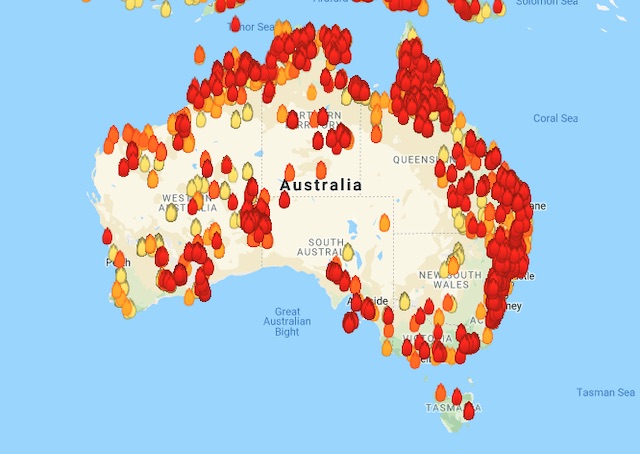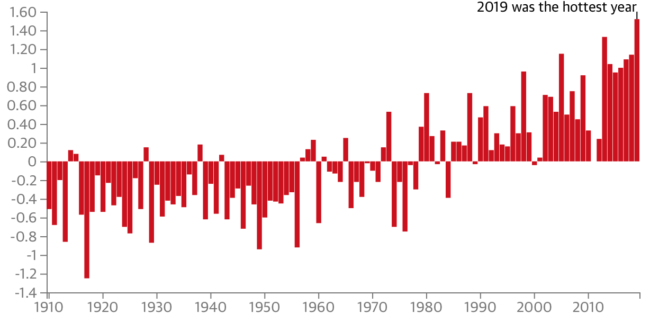
2019 has been the hottest year on record in Australia – 1.5C above average temperature. This is not opinion, the data from the Bureau of Meteorology data shows the average temperature across the country was 1.52C above the long-term average taken between 1961 and 1990. The second hottest year was 2013, followed by 2005, 2018 and 2017.
A few other related figures to note are these …
- 2019 was the hottest year on record for New South Wales, with temperatures 1.95C above the long-term average, beating the previous record year, 2018, by 0.27C
- Western Australia also had its hottest year, with temperatures 1.67C above average, beating the previous 2013 heat record by 0.58C
- On Wednesday 18 December, Australia experienced its hottest day on record with an average maximum temperature of 41.9C (107.4F), beating the previous record by 1C that had been set only 24 hours earlier
Annual Climate Statement
On 9th January the official climate statement for Australia is due to be released. This will use the long-term ACORN-SAT data.
A bureau spokesperson has explained that they will provide official comment on the 2019 temperatures in its annual climate statement on January 9. It will include a … “comprehensive analysis of the year’s weather events and climate context, including any records of note”.
Is Climate Change causing the Bushfires?
The short simple answer is yes, the subject matter experts are in no doubt about this. While natural cycles might indeed be in play, climate change has given it all a boost.
Prof Mark Howden, the director of the ANU Climate Change Institute is quoted via here as follows …
the continued rising levels of greenhouse gases in the atmosphere, caused mainly by burning fossil fuels, was the underlying driver of the heat.
He said: “It’s very clear that greenhouse gas emissions are changing the radiation balance of the Earth. Other contributors are minor in comparison.”
He said two other climate systems had also played a role in delivering the record hot year.
The Indian Ocean Dipole system had drawn moisture away from the centre of the continent, causing extra heat to build there. Another system known as the Southern Annular Mode had also contributed to the heat.
Graphic Illustration
The following illustrates the difference between the average temperature from 1961–1990 and the average temperature in a given year …

Denial persists
From here … (Scott Morrison, the Australian PM, and also Climate denialist) …
In his New Year’s Eve address to the nation, Morrison did not make any connection between the bushfires and global heating, suggesting that while they were a terrible ordeal, Australians had faced similar trials throughout history.
Past generations had “also faced natural disasters, floods, fires, global conflicts, disease and drought” and overcome them, the prime minister said in a video message. “That is the spirit of Australians, that is the spirit that is on display, that is a spirit that we can celebrate as Australians.”a
… and there is also this …
Criticism of the Morrison government’s climate stance has intensified as the fires have raged. Australia is the world’s largest exporter of coal and liquefied natural gas, but the prime minister, who won a surprise election victory in May, last month rejected calls to downsize Australia’s lucrative coal industry.
Michael E Mann speaks up
Michael E Mann is perhaps one of the best known climate scientists today. He writes as follows …
…After years studying the climate, my work has brought me to Sydney where I’m studying the linkages between climate change and extreme weather events….
…The brown skies I observed in the Blue Mountains this week are a product of human-caused climate change. Take record heat, combine it with unprecedented drought in already dry regions and you get unprecedented bushfires like the ones engulfing the Blue Mountains and spreading across the continent. It’s not complicated….
… The warming of our planet – and the changes in climate associated with it – are due to the fossil fuels we’re burning: oil, whether at midnight or any other hour of the day, natural gas, and the biggest culprit of all, coal. That’s not complicated either….
…the prime minister, Scott Morrison, appears remarkably indifferent to the climate emergency Australia is suffering through, having chosen to vacation in Hawaii as Australians are left to contend with unprecedented heat and bushfires….
…Morrison has shown himself to be beholden to coal interests and his administration is considered to have conspired with a small number of petrostates to sabotage the recent UN climate conference in Madrid (“COP25”), seen as a last ditch effort to keep planetary warming below a level (1.5C) considered by many to constitute “dangerous” planetary warming….
I think it is also wholly appropriate for Mike to have the last work here with this last quote from him …
“for Australia, dangerous climate change is already here. It’s simply a matter of how much worse we’re willing to allow it to get”
Further Reading
- BBC (1st jan 2020) – Australia fires: Death toll rises as blazes destroy 200 homes
- Guardian (1st Jan, Michael E Mann) – Australia, your country is burning – dangerous climate change is here with you now
- Time – Wildfires Are Raging Outside Every Major City in Australia
